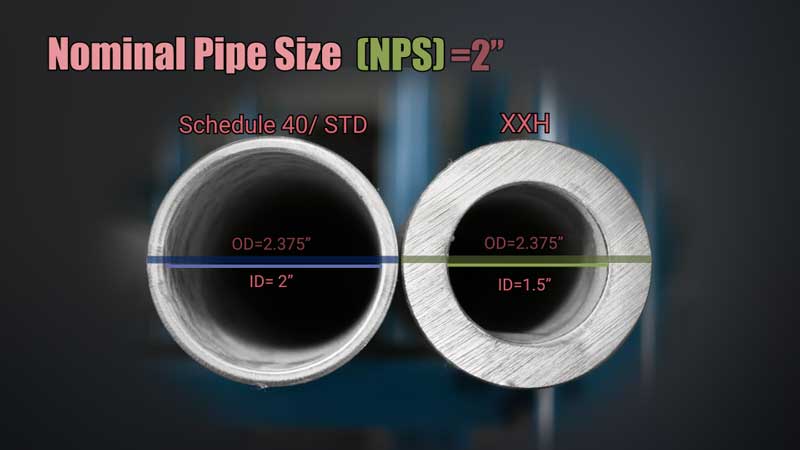Lost in the Acronym Jungle?

Are you lost in a sea of Piping Terminology?
We don’t blame you, all industries have their own jargon, but the pipe and pipe fittings industry just might surpass all the rest.
Let’s discuss the terms and acronyms that are casually thrown around by industries.
“What is a 2” pipe?”

This is the first question that trips folks up about pipe. How do we classify and denote size?
Nominal Pipe Size (NPS) is typically used to classify the outside diameter (OD) of a pipe. That said, an NPS of 2” has an actual OD of 2.375 inches.
The OD of any NPS is constant and the inside diameter (ID) varies by the Schedule. Maintaining a constant OD allows pipe fittings to be standardized, a benefit to both manufacturers and end-users
The NPS and Schedule together define the wall thickness of a given pipe, from there we can extrapolate the ID. There are two systems commonly used to specify Schedule. The older of the two classifies pipe as Standard (STD), Extra Heavy (XH), and Double Extra Heavy (XXH). As a wider range of wall thicknesses became available, a numerical system was introduced to specify a schedule. Common specifications are Schedule 10, 20, 40, 80, and 160. For small pipes, Schedule 40 is the same as STD and Schedule 80 is the same as XH, but these diverge on pipes of NPS 12” and larger.
Schedule 40 is the most common and for any pipe 12” or less, The ID of a Sch 40 or STD pipe is the named NPS diameter (for a 2” NPS Schedule 40 Pipe the ID is actually 2”). Above an NPS of 10”, the NPS corresponds to the OD of the pipe.
A Specification Chart is used to lookup the relationships between NPS, Schedule, OD, Wall thickness and weight(lb/ft). ID and total weight can be calculated:
ID = OD - (2 x Wall Thickness) Total Weight = Length x lb/ft
How are pipes made?
There are two ways pipes are manufactured: ERW and Seamless.
Electric Resistance Welded (ERW) pipe starts as a flat sheet of steel. It is rolled into a cylinder and then welded where the two edges meet to form a pipe.
Seamless (SMLS) pipe starts as a billet or solid cylinder of steel. The billet is heated and then stretched over a piercing rod to form a pipe. The inside of a seamless pipe is smooth since it does not have a welded seam.
How are pipe ends finished?
Pipe ends are typically threaded to accommodate pipe fittings or beveled to allow for easy welding.
Threaded ends for most carbon steel pipe conform to National Pipe Thread (NPT) standards. Pipe fittings also conform to NPT standards allowing pipes to be easily mated with couplings or other threaded fittings.
Many acronyms are used as shorthand for the pipe end finishes:
- TOE: Threaded One End - Pipe is threaded on only one end. The other end can be specified as beveled or plain.
- TBE: Threaded Both Ends - Pipe is threaded on both ends to accommodate fittings.
- TC or T&C: Threaded and Coupled - Pipe is threaded on both ends, and coupling is attached to one end.
- PE: Plain End - Pipe end is cut square.
A Bevel is an angle (usually 30 degrees) ground or forged into the end of a pipe or fitting. Mating two beveled ends allow the pipes or pipe and fitting to be easily and securely buttwelded together.
How do we finish a pipe?
Finishes are applied to protect the pipe. Carbon Steel Pipes are typically classified as BLK (Black), Galvanized (GALV) or Uncoated.
- Black Pipe is finished with a varnish type of oil. The oil provides limited protection and corrosion resistance but does perform better than the uncoated pipe. It is the most common and least expensive finish option.
- The galvanized pipe is coated in zinc to provide increased corrosion resistance. The zinc coating is applied by dipping the pipe into molten zinc (Hot Dipped) or via electroplating zinc to the steel sheets before the pipe is made.
- BPE: Black Plain End
- GPE: Galvanized Plain End
- GTC: Galvanized Threaded and Coupled
What is the grade of a pipe?
Pipe Grades are defined by organization standards to classify metallurgy and indicate the expected strength of a given pipe. The most common grades are:
- A106B: ASTM grade of seamless pipe is suitable for high pressure/temperature applications.
- A53A: ASTM grade of ERW pipe intended for use in mechanical and pressure applications.
- A53B: ASTM grade of seamless or ERW pipe intended for use in mechanical and pressure applications. This pipe has slightly higher carbon content than A53A.
Standards
The word “Standards” comes up frequently, but what are they and why do we have them? A standard is a set of specifications maintained by an organization allowing us to classify and evaluate pipe across industries. The American Petroleum Institute (API) and the American Society for Testing Materials (ASTM) are the two most notable organizations that publish standards.
Categories: Everything else